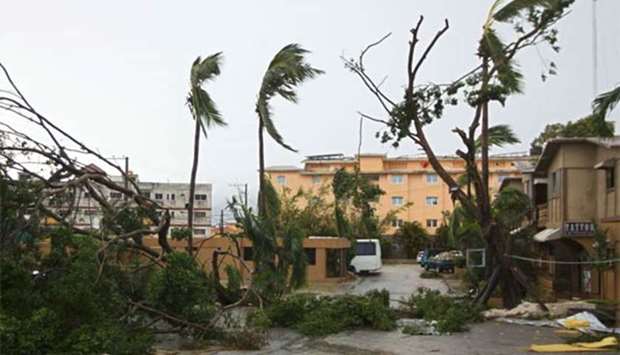Deadly Hurricane Maria flooded parts of the Dominican Republic on Thursday and continued to dump heavy rain on the US territory of Puerto Rico after destroying buildings and knocking out power to the entire island.
The second major hurricane to rage through the Caribbean this month, Maria has killed a total of 17 people and devastated several small islands, including St. Croix in the US Virgin Islands and Dominica.Maria was carrying sustained winds of up to 115 miles per hour (185 km per hour) as it moved away from the Dominican Republic on a track that would take it near the Turks and Caicos Islands and the southeastern Bahamas on Thursday night and Friday, the US National Hurricane Canter said in an advisory.
The hurricane was ranked a Category 4 storm, near the top of the five-step Saffir-Simpson scale, with winds of up to 155 mph (250 kph), when it made landfall on Puerto Rico on Wednesday as the strongest storm to hit the island in nearly 90 years.
Officials in Puerto Rico, home to 3.4mn people, were still assessing the extent of the damage. US President Donald Trump told reporters the storm "totally obliterated" the island.
Puerto Rico Governor Ricardo Rossello said there was one death reported so far, a man struck by a piece of lumber hurled by high winds.
"It's nothing short of a major disaster," he said in a CNN interview, adding it might take months for the island's electricity to be completely restored. He imposed a dusk-to-dawn curfew that runs through Saturday.
In the historic heart of the island's capital San Juan, which has a fort and buildings from the Spanish colonial era, the storm left a litter of broken branches, trees and other debris.
Aiden Short, 28, a debris management worker from London, said he had headed to the British Virgin Islands to help clean up the devastation of Hurricane Irma when Maria trapped him in San Juan.
"I was supposed to have come as a professional, but now I've just had to weather the storm," Short said. "But now it looks like I might be useful here."
All of Puerto Rico was under a flash flood warning early on Thursday as the tail end of the storm could bring another 4 to 8 inches (10-20 cm) of rain on Thursday, bringing the storm's total to 35 inches (89 cm) in parts of the island, the NHC said.
Government shelters
The government did not yet have an estimate of how many homes and businesses were destroyed by the storm. But authorities expected to see more people go to shelters on Thursday as they realised how badly their homes were hit, said Pedro Cerame, a spokesman for Rossello.
Thousands went to government shelters during the storm.
The island's recovery could be complicated by its financial woes as it faces the largest municipal debt crisis in US history. Both its government and the public utility have filed for bankruptcy protection amid disputes with creditors.
The American Public Power Association said it was bringing in both utility and contractor crews from various parts of the United States to help with recovery efforts.
Maria was about 120 miles (193 km) north of Punta Cana, on the east coast of the Dominican Republic on Thursday, the NHC said.
Punta Cana, a popular tourist area, was hit with wind gusts of 58 mph (93 kph) and Maria was forecast to bring storm surges, when hurricanes push ocean water dangerously over normal levels, of up to 6 feet (1.83 m) in the Dominican Republic, it said.
Some 1,255 homes in the Dominican Republic were damaged by the storm, the country's Center for Emergency Operations said in a statement. The northeastern coastal town of Miches was among badly affected places, with hundreds of houses damaged and downed trees blocking access roads, the newspaper Diario Libre said.
All schools and public businesses were closed and government officials ordered people to remain indoors.
Maria, which could strengthen somewhat over the coming day or so, was forecast to move north in the Atlantic Ocean over the weekend, the NHC said. It currently looked unlikely to hit the continental United States.
It was a rare Category 5 storm when it struck Dominica on Monday night, damaging about 95 percent of the roofs on the island of 73,000 people, one of the poorest in the Caribbean, the UN Office for the Coordination of Humanitarian Affairs said. At least 14 people died on the island, CNN quoted Charles Jong, a spokesman for Dominica prime minister's office, as saying.
Two people were killed in the French territory of Guadeloupe.
The governor of the US Virgin Islands ordered a round-the-clock curfew on St. Croix until further notice, saying that having anyone on the roads would hamper clean-up efforts after Maria passed just west of the island on Wednesday.
As many as 70% of buildings on the island, which is home to about 55,000 people, were damaged, said Holland Redfield, who served six terms in the US Virgin Islands senate.
The US and British Virgin Islands were also hit this month by Hurricane Irma, which ranked as one of the most powerful Atlantic storms on record. It left a trail of destruction in several Caribbean islands and Florida, killing at least 84 people.



